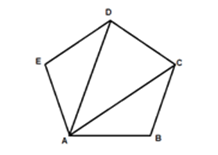10th Grade > Biology
HOW DO ORGANISMS REPRODUCE MCQs
:
B
The egg cell, or ovum (plural ova), is the female reproductive cell (gamete) in sexually producing organisms. The egg cell is typically not capable of active movement, and it is much larger (visible to the naked eye) than the sperm. The motile germ cell is sperm. The primary function of the sperm is to pass on the necessary biological information required to produce a new organism. This is true for all the organisms which reproduce sexually.
:
A
One pair of ovaries and testis are present in human females and males respectively. Ovaries produce ovum and sperm is produced by the testis. Ovum is the female gamete and sperm is the male gamete. Ovum and sperm fuse to form the zygote.
:
A
P, Q, R and S are the fallopian tube, ovary, uterus and vagina respectively.
In the process of fertilisation, a mature ovum is released from either one of the ovaries. The sperm or the male gamete travels into the uterus and into the fallopian tube where the fertilisation takes place. After the fusion of the male and the female gamete, a fertilised egg or the zygote is formed. Gradually this zygote gets implanted into the wall of the uterus where the baby develops and gets its nourishment from the mother.
:
B
Pollination is the transfer of pollen grains from the anther of one flower to the stigma of the same or another flower. Pollen grains contain the male gamete and are present in the anthers of the flower. If the pollen grains land on the sticky surface called stigma of a suitable flower of the same species, a chain of events happen that ends in the development of seeds. The pollen grain on the stigma, grows a tiny tube, all the way down the style to the ovary. The ovary develops into a fruit after fertilisation.
:
A, B, C, and D
Asexual reproduction is a mode of reproduction by which offspring arise from a single organism and inherit the genes of that parent only. It does not involve the fusion of gametes. Budding, fission, fragmentation and vegetative propagation are examples of asexual reproduction.
:
C
Vas deferens is a part of the male reproductive system. It is a duct that carries sperms from epididymis to copulatory organ. Along the way, secretions from seminal vesicles and prostate glands are added to the sperms. Ovary, uterus, fallopian tubes are parts of the female reproductive system.
:
D
The process of doubling and replicating the genetic material in the human cells is known as DNA replication and meiotic cell division reduces chromosome number to half in sex cells. DNA replication is essential for cell division to take place.
:
C
The gestation period is the period of foetal development starting from fertilisation and ending at parturition or childbirth. During this period, the single-celled zygote undergoes gradual changes that help it to become a functional multicellular organism. The gestation period in human beings is about 270-280 days (9 months).
:
C
A condom can be worn by a man over his penis which helps in the prevention of STDs and also prevents unwanted pregnancies. Copper T, oral pills and diaphragm are examples of female contraceptives which do not prevent STDs.
:
C
Ovum or ova is the female gamete produced by the ovaries. It is a non-motile structure larger than a sperm. It is a single, haploid cell with several protective layers outside its cell membrane.

















